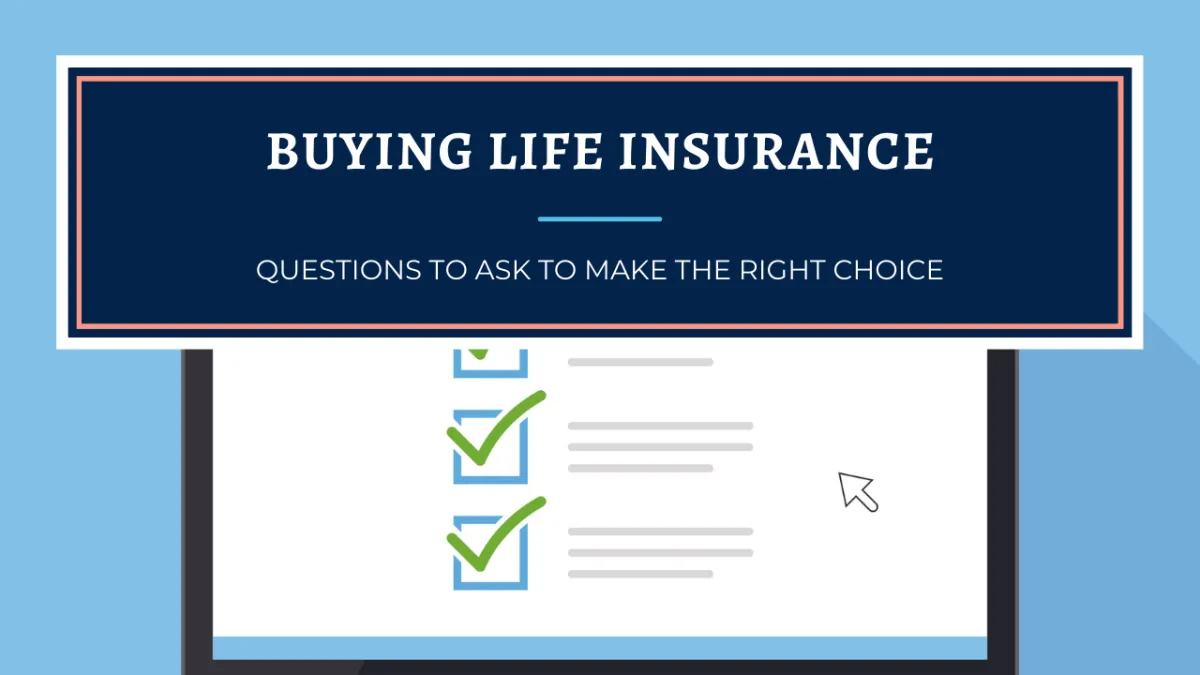
9 Questions to Ask Before Buying Life Insurance
Now, we continue the conversation from Part 1 to discuss the questions to ask after the application and before actually buying life insurance.
These questions are relevant to whole life insurance and may not apply to other types of life insurance, especially types with little or no cash value, or life insurance that does not guarantee the death benefit permanently. How will you know? Ask the questions.
How much life insurance should you get?
“Needs analysis” is a common way to determine how much life insurance to purchase. It can provide insights, such as insuring you obtain adequate amounts to pay off a mortgage or replace a breadwinner’s income. However, it’s not always a helpful guideline.
Look at it this way: Let’s say you lived in a beautiful five bedroom, three bath home with a view, and the house burned down. Would you want home insurance that would replace your full loss? Or would you simply want to cover your “need” for shelter? Of courses, you’d want insurance that would replace your home’s full value!
That’s why we recommend that clients insure their full Human Life Value instead. Human Life Value is a financial term that indicates how a person’s monetary “worth” is measured for the purpose of life insurance and also wrongful death lawsuits. Human Life Value helps you assess and protect the full financial loss your family would incur if you were to die today, while a needs-based assessment can sell you (and your beneficiaries) short. Someone we know used a Human Life Value calculator and an Insurance Needs calculator to compare… her Human Life Value is nearly $2 million, but her “needs” were calculated at less than $200k!
Since few people can insure their Human Life Value with one whole life policy, many people have multiple policies, both term insurance (preferably convertible term insurance) and whole life. Over time, term policies can be converted or replaced by whole life as your financial capability builds.
No insurance company will ensure someone for unlimited amounts of insurance. Your Human Life Value is the upper limit of what you can apply for, and the amount of life insurance you actually obtain is largely a function of cash flow. Premium payments should be high enough to help you satisfy your savings goals—assuming building cash value and liquidity is one of your aims—but not more than you can afford. (You can also apply for a higher amount while deciding and crunching numbers, and settle on a policy for less than the approved amount.)
Is the policy structured for maximum Cash Value or maximum Death Benefit?
Most people choose to maximize for cash value, which means maximizing Paid-Up Addition (PUA) riders. This accelerates the build-up of cash value within a whole life policy in the early years, while also increasing the death benefit over time. If your goal is to store cash and increase liquidity, you will definitely want to use a Paid-Up Additions Rider.
Some people prefer to maximize the death benefit instead. Perhaps you already have policies or other assets with ample cash value, and your goal is to increase the worth of your estate rather than expand your own cash and liquidity. In that case, the policy can be structured for a larger permanent death benefit and slower cash value accumulation.
When designing and buying life insurance, everything is a tradeoff. Except in extreme cases, a balance between early cash value and death benefit provides the best outcome, with most options to take advantage of opportunities in the future.
Remember, there can be no cash value without the death benefit!
Does the policy have a “Direct Recognition” or “Non-Direct Recognition” loan provision?
Direct recognition policies adjust the dividends paid on a policy when there is an outstanding policy loan, non-direct recognition policies do not. Owning a direct recognition policy can affect your dividends either positively or negatively, though only by a small amount. And while there are pros and cons to either, they are fairly minor.
We agree with TheInsuranceProBlog.com’s conclusion: “When it comes down to it, one is not superior to the other. All this talk about [one or the other] is a game of smoke and mirrors used to keep your focus away from the really important stuff.”
The bottom line: Out of all the other factors to consider when buying life insurance, dividend recognition is small potatoes. As Nelson Nash said: worrying about dividend recognition is "majoring in the minors."
How does a policy loan affect the policy values?
This is good information for you to know, as policy loans typically reduce the death benefit, especially if not paid back quickly. And as mentioned above, policy loans may also affect your dividends.
What is the interest rate charged for a policy loan?
The ability to borrow against your policy is a nice benefit of having cash value. You can access cash within about a week, and there’s no income or credit check. Some banks will lend you money with your cash value as collateral, often at more favorable interest rates, which gives you two ways to borrow against your cash value. (You can also simply withdraw the cash, although we don’t usually recommend that unless repaying the loan would be a hardship.)
Some things to know:
What is the current policy loan rate?
Is the interest rate fixed or variable?
If variable, what is the maximum guaranteed interest rate for a policy loan?
As with “direct vs. non-direct recognition,” there are pros and cons either way with “fixed vs. variable,” and either option can work just fine. In recent years, variable interest rate policy loans have had more favorable rates, but variable interest loan rates will go higher when interest rates rise. Some people with multiple policies will have both, giving them the option to borrow against whichever one has the most favorable interest rate at the time.
Is there a Waiver of Premium rider on the policy?
Waiver of premium is a rider or clause in an insurance policy that would waive your obligation to pay any further premiums should you become disabled. In this way, your policy would continue to save FOR you, while also building your death benefit, even if you could no longer work. The rider may require the insured to be disabled for a certain amount of time, such as six months, and some companies may also place qualifying requirements on the policyholder, such as being in good health or below a certain age.
There is an extra charge for this rider, which varies according to the size of the policy, age and other factors. We can show you how this and other riders will affect the cost or potential performance of your policy.
Is there a Terminal Illness rider available on the policy?
A terminal Illness rider is an optional rider that allows the policyholder to “accelerate” all or part of the death benefit upon diagnosis of a terminal illness when the insured is not expected to live beyond a certain time frame (such as 12 months). This rider allows the insured to literally “spend their death benefit while living,” which can help them pay medical bills, settle their affairs, obtain alternative treatments, travel if they are able, and gift or spend money in ways that are meaningful to them.
There may be an additional charge for this benefit, although it can be provided at no extra cost from certain companies, which makes it a “no brainer!”
Should you backdate your life insurance policy?
Backdating a policy six months is a way to get through the “funding phase” of a policy more quickly, as you’ll pay the second year six months after the policy begins. (We recommend Live Your Life Insurance to find out more about the different phases and how to get the most from your policy.) It may also “backdate” your age, which could have a slight advantage.
If your goal is accelerating cash value and if making two annual payments within six months is no problem, this could be worth considering. We can help you compare the options.
Will you pay for the policy annually or monthly?
There is generally also a quarterly option, although most people prefer annually or monthly. It costs a bit extra to do monthly (we can give you the comparison), but if monthly works best for your cash flow, you should do what works for your situation. You can always have the company change your payment plan down the road.
Decisions, Decisions!
As you can see, there are a lot of decisions to make when getting life insurance! (And you may have questions we haven’t included or haven’t even thought of.) Don’t worry… It’s really not complicated, and we’ll walk you through it, which makes it much easier!
© Prosperity Economics Movement, StackedLife LLC

